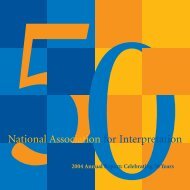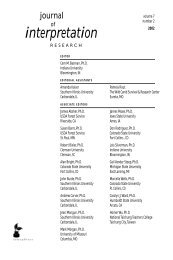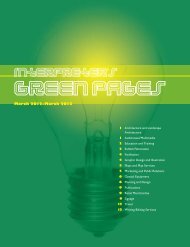interpretation
Volume 15, Number 1 - National Association for Interpretation
Volume 15, Number 1 - National Association for Interpretation
You also want an ePaper? Increase the reach of your titles
YUMPU automatically turns print PDFs into web optimized ePapers that Google loves.
e v a l u a t i n g s i g n e f f e c t i v e n e s s<br />
of littering in a university quad, a banner with a mundane message (“Be clean and<br />
green. Please throw it in the bin.”) failed to decrease littering, whereas a banner with an<br />
unusual message (“Yesterday, x% of males littered and x% of females littered. You know<br />
the odds. Now beat them!”) caused a drop of more than 50% in the rate of littering.<br />
A third major limiting factor with respect to signs is visitors’ feelings of familiarity<br />
with the topics addressed. Such feelings can minimize message processing because a<br />
person “already knows the message” and therefore fails to attend to a message enough<br />
to process it (Garcia-Marques & Mackie, 2001; Rogers, Lamson, & Rousseau, 2000). For<br />
example, a park visitor may glance at an interpretive sign about food storage, classify it<br />
(“a typical park sign”) or make a judgment about the content (“I know the rules; I don’t<br />
need to read it”), and end up paying no attention to the actual content. In their research<br />
related to standard National Park Service signs in Yosemite, Hall, Hockett, and Smith-<br />
Jackson (2001) reported that visitors interviewed about their reactions to signs often<br />
considered them to be familiar and not worth reading. In another study, Lackey, Ham,<br />
and Quigley (2002) determined that, at any given moment, hundreds of messages about<br />
bears were simultaneously vying for the attention of Yosemite visitors.<br />
It makes sense, then, that visitors may direct their attention to other things than<br />
a sign or they may be functioning in a mindless, inattentive state. Human attention<br />
systems evolved to notice unusual or emotional things, contrast, certain colors, or<br />
movement (Sylwester & Cho, 1992/3). Typically signs (including those in national parks)<br />
do not contain any of these elements that engage the automatic orienting response<br />
(Lang, 2000). Hence, park signs may lose in the competition with stimuli from the<br />
natural or social environment that are comparatively more novel to visitors.<br />
Study Purpose<br />
Our initial research, together with that of others, suggested that capturing visitor<br />
attention with signs was a major limiting factor at Yosemite. More than 75% of visitors<br />
are repeat visitors, and it was clear that many do not attend to signs as a matter of<br />
routine. Therefore, our study was undertaken to explore alternative approaches to<br />
designing signs with bear messages that might better capture the attention of visitors.<br />
Our objectives were (1) to determine how well newly designed theoretically based<br />
test messages attracted the attention of visitors and how long people read them; (2) to<br />
understand, in visitors’ own words, how they responded to and evaluated the signs; and<br />
(3) to compare five different versions of message content in three locations, each based<br />
on a different theoretical approach to communication.<br />
Theoretical Approaches to Capturing and Holding Attention<br />
In park settings, visitors’ feelings of familiarity and pre-established behavioral schemas<br />
can work against interpreters. In response to this challenge, interpreters must develop<br />
communication approaches that succeed in stimulating enough attention to media (such<br />
as signs) that their messages are, in fact, processed and encoded by visitors (Moscardo,<br />
1996). Two techniques for doing this have shown promise: novel designs and use of vivid<br />
information. Change is intrinsically interesting to people (Sylwester & Cho, 1992/3),<br />
including visitors in free-choice learning environments (Falk & Dierking, 1992; Falk &<br />
Storksdieck, 2005; Ham, 1992). Designs that are novel are thought to interrupt scripted<br />
behaviors and arouse focused attention (Werner et al., 1998). Novelty can be introduced<br />
via placement of a sign in a new or unexpected location as well as through elements of<br />
v o l u m e 15, n u m b e r 1 17












